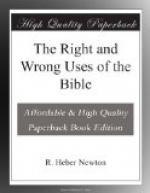Like the Catholic Church, the Jewish priesthood held society together when, in the destruction of the political power, there was no other bond of unity. As in the Catholic Church, the High Priest became a temporal ruler, the Prince of Israel, as he was called; and kept the sacred city still the seat of government. As in Catholicism the institutionalizing of religion that followed the period of free prophetic life was an effort to embody that life, to incrust and thus preserve it; and, in the one case as in the other, though the crust of institutions choked the further growth of spiritual religion, it yet did keep it sluggishly alive within this hard bark, through times that else would have proved fatal to it. As in Catholicism, this priestly cultus really drilled deep into the natures of men the principles and laws and habitudes of ethical and spiritual religion; and stored the force which, when its rigid routine and fettering formalism became unbearable, burst through this crust and opened a new world of fresh, free life.
Of this singular shaping of the nation’s experiences to further the growth of true religion, the Old Testament is the impressive record.
6. Israel’s literature thus presents the picture of a nation’s patient, insistent pressing forward, through long centuries, toward the fruition of its ideal, the realization of true religion.
So continuous is Israel’s movement toward the ideal of religion, so straight the line of her advance that it seems as though the nation had a conscious aim, seen afar and steadfastly pursued by generation after generation, unwilling to stop short of attainment. It is the founder of scientific Biblical criticism who thus expresses his sense of the wonderfulness of this historic movement:
“This aim is Perfect Religion; a good which all aspiring nations of antiquity made an attempt to attain; which some, the Indians and Persians, for example, really labored to achieve with admirable devotion of noble energies, but which this people alone clearly discerned from the beginning, and then pursued for centuries through all difficulties, and with the utmost firmness and consistency, until they attained it, so far as among men and in ancient times attainment was possible."[22]
7. The literature of Christian Israel records the realization of this long sought ideal, the fruition of this organic growth.




